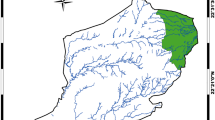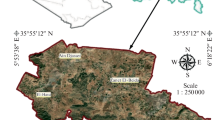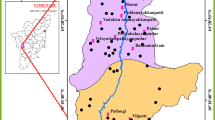Abstract
In recent decades, the high population growth has increased the demand for agricultural lands and products. Groundwater offers reliability and flexibility in access to water for irrigation purposes, especially in arid and semi-arid areas, such as Amol-Babol Plain, Iran. However, the quality and quantity of groundwater may not be suitable for irrigation purposes in all areas due to urbanizations, and intensive agricultural and industrial activities. Groundwater suitability zoning for irrigation purposes could be useful to improve water resources and land use planning, mostly in areas with water scarcity. Therefore, a GIS-based indices method is proposed to assess suitable zones for agricultural activities, integrating the irrigation water quality (IWQ) index and hydrogeological factors. IWQ index was utilized to assess groundwater quality based on salinity hazard, infiltration hazard, specific ions, and trace elements hazards, and miscellaneous effects such as pH, bicarbonate, and nitrate. The potential of the aquifer for irrigation water abstraction was investigated using hydrogeological surveys such as slope angle of the plain, hydraulic conductivity, and aquifer thickness. The groundwater suitability index classified most of the study area (more than 90 %) as “excellent” or “good” suitability zones for irrigation purposes. A limited area of around 5.6 % of the total area has moderate suitability for irrigation purposes due to the Caspian Seawater intrusion and the presence of fossil saline water. The proposed methodology provides useful information in order to allow irrigation management to prevent water and soil deterioration.







Similar content being viewed by others
References
Adhikari K, Chakraborty B, Gangopadhyay A (2013) Assessment of irrigation potential of ground water using water quality index tool. Asian J Water Environ Pollut 10(3):11–21
Adhikari P, Shukla MK, Mexal JG, Sharma P (2011) Assessment of the soil physical and chemical properties of desert soils irrigated with treated wastewater using principal component analysis. Soil Sci 176(7):356–366
Aghanabati SA (2004) Geology of Iran (to Persian). Geological Survey of Iran Publications, Tehran
An Y, Wang Y, Zhang H, Wu X (2012) GIS-based suitability assessment for shallow groundwater development in Zhangye Basin. Procedia Environ Sci 12, Part B(0):1397–1403. doi:10.1016/j.proenv.2012.01.442
APHA (2005) Standard methods for the examination of water and wastwater, 21 edn. American Public Health Association, American Water Works Association, Water Environment Federation, Washington DC
Ashraf S, Afshari H, Ebadi AG (2011) Geographical information system techniques for evaluation of groundwater quality. Am J Agric Biol Sci 6
Assaf H, Saadeh M (2009) Geostatistical assessment of groundwater nitrate contamination with reflection on DRASTIC vulnerability assessment: the case of the upper Litani Basin, Lebanon. Water Resour Manag 23(4):775–796. doi:10.1007/s11269-008-9299-8
Ayers RS, Westcot DW (1985) Water quality for agriculture. FAO irrigation and agriculture organization. U.N. Food and Agriculture Organization, Rome
Debels P, Figueroa R, Urrutia R, Niell X (2005) Evaluation of water quality in the Chillan River (Central Chile) physicochemical parameters and modified water quality index. Environ Monit Assess 110:301–322
Eaton EM (1950) Significance of carbonate in irrigation water. Soil Sci
ESRI (2003) Using ArcGIS geostatistical analyst. Environmental Systems Research Institute, USA
Fakharian K (2010) Hydrogeology report of Amol-Babol plain, study of prevention, control and reduce pollution of Amol-Babol aquifer (Persian ed.). Department of Environment of Iran, through a contract with Amirkabir University of Technology
FAO (1994) Water quality for agriculture. Food and Agriculture Organization of the United Nations Rome
Forno DA, Yoshida S, Asher CJ (1975) Zinc deficiency in rice. Plant Soil 42(3):537–550. doi:10.1007/bf00009941
Gazzaz NM, Yusoff MK, Aris AZ, Juahir H, Ramli MF (2012) Artificial neural network modeling of the water quality index for Kinta River (Malaysia) using water quality variables as predictors. Mar Pollut Bull
Hajiboland R, Salehi SY (2006) Zinc efficiency is not related to bicarbonate tolerance in Iranian rice cultivars. J Agron 5(3):497–504
Haritash AK, Kaushik CP, Kaushik A, Kansal A, Yadav A (2008) Suitability assessment of groundwater for drinking, irrigation and industrial use in some north Indian villages. Environ Monit Assess 145(1–3):397–406. doi:10.1007/s10661-007-0048-x
Horton RK (1965) An index number system for rating water quality. J Water Pollut Control Fed 37(3):300–306
Jafar Ahamed A, Loganathan K, Ananthakrishnan S (2013) A comparative evaluation of groundwater suitability for drinking and irrigation purposes in Pugalur area, Karur district, Tamilnadu, India. Arch Appl Sci Res 5(1):213–223
Liou S-M, Lo S-L, Wang S-H (2004) A generalized water quality index for Taiwan. Environ Monit Assess 96(1–3):35–52
Mahab (2004) Supplementary environmental and social assessment of Alborz, integrated land and water management project (Persian), vol 2. Mahab Ghods Consulting Engineers
Manap MA, Nampak H, Pradhan B, Lee S, Sulaiman WNA, Ramli MF (2014) Application of probabilistic-based frequency ratio model in groundwater potential mapping using remote sensing data and GIS. Arab J Geosci 7(2):711–724
Mohebbi MR, Saeedi R, Montazeri A, Azam Vaghefi K, Labbafi S, Oktaie S, Abtahi M, Mohagheghian A (2013) Assessment of water quality in groundwater resources of Iran using a modified drinking water quality index (DWQI). Ecol Indic 30:28–34
Nampak H, Pradhan B, Manap MA (2014) Application of GIS based data driven evidential belief function model to predict groundwater potential zonation. J Hydrol 513:283–300
Narany TS, Ramli MF, Aris AZ, Sulaiman WNA, Fakharian K (2014) Spatiotemporal variation of groundwater quality using integrated multivariate statistical and geostatistical approaches in Amol–Babol plain, Iran. Environ Monit Assess 186(9):5797–5815
Narany TS, Ramli MF, Aris AZ, Sulaiman WNA, Fakharian K (2015) Groundwater irrigation quality mapping using geostatistical techniques in Amol–Babol plain, Iran. Arab J Geosci 8(2):961–976
Neshat A, Pradhan B (2015) Risk assessment of groundwater pollution with a new methodological framework: application of Dempster–Shafer theory and GIS. Nat Hazards 78(3):1565–1585
Neshat A, Pradhan B, Shafri HZM (2014a) An integrated GIS based statistical model to compute groundwater vulnerability index for decision maker in agricultural area. J Indian Soc Remote Sens 42(4):777–788
Neshat A, Pradhan B, Pirasteh S, Shafri HZM (2014b) Estimating groundwater vulnerability to pollution using a modified DRASTIC model in the Kerman agricultural area, Iran. Environ Earth Sci 71(7):3119–3131
Ott WR (1978) Water quality indices: a survey of indices used in the United States. US Environmental Protection Agency, Washington, DC
Rahman A (2008) A GIS based DRASTIC model for assessing groundwater vulnerability in shallow aquifer in Aligarh, India. Appl Geogr 28:32–53
Ravi Shankar M, Mohan G (2006) Assessment of the groundwater potential and quality in Bhatsa and Kalu river basins of thane district, western Deccan volcanic province of India. Environ Geol 49:990–998
Ravikumar P, Somashekar RK (2011) Geochemistry of groundwater, Markandeya River basin, Belgaum district, Karnataka state, India. Chin J Geochem 30:051–074. doi:10.1007/s11631-011-0486-6
Romanelli A, Lima M, Quiroz Londoño O, Martínez D, Massone H (2012) A GIS-based assessment of groundwater suitability for irrigation purposes in flat areas of the wet Pampa plain, Argentina. Environ Manag 50(3):490–503. doi:10.1007/s00267-012-9891-9
Sadat-Noori SM, Ebrahimi K, Liaghat AM (2013) Groundwater quality assessment using the water quality index and GIS in Saveh-Nobaran aquifer. Iran Environ Earth Sci:1–17. doi:10.1007/s12665-013-2770-8
Saeedi M, Abessi O, Sharifi F, Meraji M (2010) Development of groundwater quality index. Environ Monit Assess:327–335. doi:10.1007/s10661-009-0837-5
Shahbazi A, Esmaeili-Sari A (2009) Groundwater quality assessment in north of Iran: a case study of the Mazandaran Province. World Appl Sci J 5:92–97
Sheikhy Narany T, Ramli MF, Aris AZ, Sulaiman WNA, Juahir H, Fakharian K (2014) Identification of the hydrogeochemical processes in groundwater using classic integrated geochemical methods and geostatistical techniques. The Scientific World Journal, Amol-Babol Plain, Iran. Sci World J 2014:15
Simsek C, Gunduz O (2007) IWQ index: a GIS-integrated technique to assess irrigation water quality. Environ Monit Assess 128(1):277–300. doi:10.1007/s10661-006-9312-8
Vasanthavigar M, Srinivasamoorthy K, Vijayaragavan K, Ganthi RR, Chidambaram S, Anandhan P, Manivannan R, Vasudevan S (2010) Application of water quality index for groundwater quality assessment: Thirumanimuttar sub-basin, Tamilnadu, India. Environ Monit Assess 171(1–4):595–609
Wilcox L (1955) Classification and use of irrigation waters. US Department of Agriculture Washington
Wissuwa M, Ismail MA, Yanagihara S (2006) Effects of zinc deficiency on rice growth and genetic factors contributing to tolerance. Am Soc Plant Biol 142(2):731–741
Yidana S, Ophori D, Banoeng-Yakubo B (2008) Groundwater availability in the shallow aquifers of the southern voltaian system: a simulation and chemical analysis. Environ Geol 55(8):1647–1657
Acknowledgments
The authors acknowledge the Soil and Water Pollution Bureau of Department of Environment (DOE) in Iran for their financial support through a contract with Amirkabir University of Technology (AUT), Tehran, Iran. The financial support by DOE and the laboratory data and analyses provided by AUT are gratefully acknowledged. Special thanks are due to Mr. A. S. Mohammadlou for his sincere cooperation in providing the data.
Author information
Authors and Affiliations
Corresponding author
Ethics declarations
Conflict of interest
We certify that there is no actual or potential conflict of interest in relation to this article.
Additional information
Highlights
• Developing irrigation water quality index based on the indicators.
• We proposed new GIS-based indices approach for irrigation suitable zoning.
• Suitable zones depend on both hydrochemical and hydrogeological factors.
Rights and permissions
About this article
Cite this article
Narany, T.S., Ramli, M.F., Fakharian, K. et al. A GIS-index integration approach to groundwater suitability zoning for irrigation purposes. Arab J Geosci 9, 502 (2016). https://doi.org/10.1007/s12517-016-2520-9
Received:
Accepted:
Published:
DOI: https://doi.org/10.1007/s12517-016-2520-9




